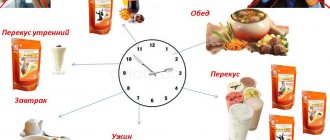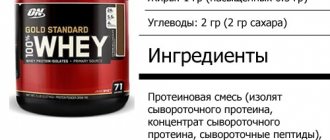It is believed that you should not eat at night, as it is harmful to your figure. Indeed, the body at rest absorbs food much worse, but at night, the muscles continue to grow and recover. They need energy for regeneration, and proteins for growth, so athletes have a logical question: can they drink protein at night?
High-protein mixtures included in sports nutrition can be taken without fear of a significant increase in dietary calories and the risk of fat deposits. In addition, they also contribute to effective protection against catabolism, which is especially acute during periods of prolonged absence of amino acid supply.
But what protein is best to drink at night?
In the morning and after training, it is urgent to satisfy protein hunger, and during this period, it is best to drink mixtures with fast proteins that are absorbed within 30-60 minutes. For the night, slow additives are suitable - casein, soy, complex.
In addition to the undoubted benefit in long-term protection of muscles from catabolism, slow supplements also reduce appetite, as they promote a feeling of fullness due to prolonged absorption in the gastrointestinal tract. Such protein at night for weight loss is simply irreplaceable - the stomach, feeling full, does not require an immediate trip to the refrigerator for a harmful night snack.
Use slow protein at night when cutting, working on relief, mass, during aerobic and strength training.
What to eat before/after training? All about sports nutrition.
If you started studying the material from this note, then I recommend holding your horses and reading the first two parts [What to eat after training. Part No. 1], [What to eat after training. Part No. 2]. In them, we examined in detail the entire theoretical side of the issue and formed a general idea of post-training intake. Therefore, to “get into the topic”, study previous posts on this topic. We will go further and talk about such an important aspect in an athlete’s nutrition as sports supplements.
Many trainers and fitness consultants like to sell sports nutrition to beginners, saying that without it you cannot achieve results, it is extremely necessary and, in general, you cannot live without it :). Following the advice from the outside, the purchase of various supplements, amino acids, proteins, gainers, fat burners and other items begins. Today we will try to find out: what sports nutrition really needs to be used before/after training, and what it, in fact, can give besides wasted money.
Note:
For better assimilation of the material, all further narration will be divided into subchapters.
Sports nutrition before training
It’s not for nothing that I decided to pay personal attention to the topic of sports nutrition, because up to 90% of workers in the gym take various kinds of supplements both before and after training. It must be said that this particular (liquid) form of supporting the body is the most optimal in terms of the onset of action and the provision of positive effects, so you need to know what and in what cases to take, and whether it is worth it.
So, the main sports nutrition before training includes:
- pre-workout complexes/pre-workouts (including those with the addition of creatine) – have a complex effect on the body, helping to carry out training at a high “ideological level”;
- fat burners/L-carnitine – supplements that help accelerate metabolism and launch fat burning processes;
- proteins/gainers – mass gain accelerators.
The class of basic post-workout supplements looks like this:
- glutamine – an assistant in the construction of new contractile proteins and a reducing agent;
- BCAA - amino acids for muscle growth and launching protein synthesis processes;
- proteins/gainers.
All of these supplements have a place in your pre/post-workout supplements. Which one you need depends on your goals, body type and when you finish training. At the end of this chapter, I will provide a summary table on sports nutrition, and now we will take a more detailed look at 2 supplements, these are...
No. 1. Glutamine after workout
The most common amino acid synthesized by the human body, which is stored in the muscles. It is the main source of fuel for the immune system. During intense training, muscles release accumulated glutamine into the blood, and its reserves are halved upon completion of physical activity . The more intense and longer the workout, the lower the reserves of this amino acid. During HIIT training and long cardio sessions, the glutamine level can be as low as 10% , i.e. there is almost complete depletion of its depot. Strength work uses up about 40-50% of glutamine reserves.
A deficiency of this amino acid contributes to the destruction and wasting of muscle tissue.
Taking a glutamine sports supplement after training solves the following problems:
- preventing muscle breakdown and the use of muscle tissue as a fuel source;
- stimulates the formation of glycogen (increasing the activity of the enzyme that creates the latter in muscle cells and the liver), thereby providing the body with energy;
- due to cellular hydration, it helps maintain cell volume (volumization process), enhancing protein synthesis and maintaining weight;
- protects the immune system by being the main source of fuel for its cells and helps in building muscles. If immune cells do not have enough free glutamine, they will steal it from somewhere.
Thus, glutamine is an important post-workout supplement (along with protein) and should be included in your post-workout diet. The most preferred option is the powder form of the supplement; it is tasteless and has a high absorption rate.
Dilute 3-6 grams of glutamine in water and add to your protein shake - this is the best refueling option for your workout-depleted muscles. If your workout ends in the early evening ( 5-7 hours), you can additionally take another serving of glutamine before bed. The morning option also has its place, so decide for yourself when to support your body.
No. 2. BCA amino acids after training
Branched chain amino acids (leucine, isoleucine, valine) that help stimulate protein synthesis and increase muscle mass. BCAs can also affect gene expression—they activate genes that encode proteins that make up ribosomes, the cellular organelles where protein synthesis occurs. Leucine and other BCAA amino acids lead to an increase in the translation of structures within cells, increasing their potential to create new proteins. All this affects the growth of pure muscle mass.
During exercise, BCAs are actually burned in muscle cells as fuel, and the muscles use them for energy. Taking amino acids immediately after training will increase their levels, and they will engage in repair and protein synthesis work.
BCAA is an important supplement for dryers, people who cut muscles. Due to a strict diet and calorie restrictions, along with fat, the gained muscle mass is lost; in order to minimize the loss of the latter, branched chain amino acids are needed. They block the breakdown of proteins, protect muscle mass, forcing the body to use fats instead. BCA also reduces levels of the catabolic hormone cortisol and increases the synthesis of anabolic testosterone.
The optimal daily dosage of BCA for an athlete weighing over 70 kg is 6-10 g. Thus, taking into account the correct diet (meaning an emphasis on lean protein and dairy products), it is enough for a man to eat 3-5 capsules (at the rate of 1 capsule = 1000 mg ) of BCAA after training. For women, the values are about 2-3 capsules.
So, let’s summarize some intermediate results (how many grams to consume) for all parts of the note regarding sports nutrition:
- before training: protein/gainer – from 20 to 40 g of dry matter, creatine – 5-20 g; L-carnitine – 1-3 grams;
- after training: protein/gainer – from 20 to 40 g, BCAA – 6-10 g, glutamine – 3-6 g.
Various strategies for taking sports supplements depending on the athlete's goals are reflected in the table.
And this is what the summary table of sports nutrition looks like before/after training for 2 main goals, mass gain and weight loss.
Let's go further and now touch on the main post-workout product, namely protein.
What is the best source of post-workout protein?
Many gym goers do not like to stuff themselves with all sorts of chemicals in the form of sports nutrition (in particular, we are talking about protein). And, really, is it necessary to consume protein powder (sports nutrition) after a workout, or can you get by with simple protein products?
The optimal solution is this approach:
- solid protein meals throughout the day;
- after training - liquid sports nutrition.
Protein powder and its liquid form are a faster source of amino acids than regular food. In sports nutrition, amino acids are already ready for use, while solid protein foods require a long time to digest. After a workout, fast refueling is important for us, and sports nutrition provides this, moreover, it increases the fractional rate of protein synthesis, i.e. muscle mass builds faster than from taking amino acids from simple food.
Most studies agree that whey proteins improve muscle hypertrophy and make athletes stronger, and the ideal time to take them is after exercise.
Note:
It is important to know that it is best to dilute sports nutrition (for example, protein/gainer) in water, because milk and dairy products contain a large percentage of casein protein, which slows down the rate of absorption of the nutritional components of the mixture. However, if you want to further increase the level of the transport hormone insulin, then it is better to dilute sporpite in milk, because it has a high insulin response.
Conclusion: Dilute protein shakes in water and drink them after your workout. If the workout ends late ( 9-10 o’clock) and the end is planned soon ( 00-00 o’clock), then in this case, organize a solid meal (protein + vegetables) without using a protein mixture.
Which protein is better? Comparison of different types.
As we already understood from the information above, after training we need protein powder, but what kind, because there are so many types of them? Let's figure it out.
Depending on which initial product acts as a source of protein, their main types that can be used by us after (as well as before) training include:
- whey protein (whey);
- casein protein (casein);
- soy (soy);
- milk (milk);
- egg
Let's take a closer look at each of them.
No. 1. Whey Protein
The second most common protein obtained from milk. The whey contains all the essential amino acids and in particular the branched chain amino acids (leucine, isoleucine and valine), as well as glutamine (an immunostimulating amino acid). Whey is considered a fast-acting protein (high absorption rate). Taking a serving of 30 g on an empty stomach creates a peak in amino acid levels in the blood within 1 hour and returns them to normal levels after 3-4 hours. This absorption profile makes whey an anabolic substance.
According to the results of recent studies conducted in the field of dietetics and sports nutrition, the use of whey leads to an increase in protein synthesis by 68% . Whey has the best effect when combined with pure carbohydrates with a high glycemic index (for example, maltodextrin).
No. 2. Casein protein
The main protein of milk, which has a relatively low absorption rate ( 2 hours, versus 1 hour for whey). It has a strong anti-catabolic effect - it is able to nourish muscles for a long time, preventing them from breaking down. Compared to whey, casein has a lower anabolic effect on the body ( 31% vs. 68% ). Casein produces a slow but steady increase in amino acids in the blood. Peak levels occur 2 hours after consumption and remain elevated for 6-7 hours.
The optimal time to take it is 45-60 minutes before going to bed and during periods of the day when the athlete will not have the opportunity to eat for a long time.
No. 3. Soy protein
The best source of non-animal protein, which is often accused of being inferior to proteins from animal sources in the amino acid methionine. With a balanced diet, this small drawback disappears. Most studies say that soy protein is comparable in digestibility to quality protein sources such as meat, fish, and eggs. Recent research shows that replacing some animal-based meals with soy-based ones has been effective in reducing body fat mass and bad cholesterol levels.
Soy protein is an excellent post-workout solution for vegetarians. In addition, soy can be used as a substitute for animal proteins in the main diet.
Note:
Due to the high amount of genetically modified products and, especially, soybeans on the nutrition market, it is not possible to recommend them for use by athletes if you are not sure about the sports nutrition manufacturer and the specific product.
No. 4. Milk protein
Milk is not only for children, if you are engaged in changing your shape and you do not have lactose intolerance (milk sugar), then milk/dairy products should be in your diet. Milk contains biologically active peptides that provide the athlete’s body with the necessary amino acids. Cow's milk contains 74% casein protein, 18% whey protein 3% glycomacropeptides, 3% peptone protease, 2% other proteins. For lean muscle mass, the diet should mostly include skim milk.
It is optimal to take milk protein/milk before bed or in the morning before your next long meal.
No. 5. Egg protein/albumin
What came first, the egg or the chicken? :).
An egg is a 2 in 1 , its whites are the standard source of protein, and the yolks are a source of both protein and vitamins/minerals. The yolk contains cholesterol, from which the main male anabolic hormone, testosterone, is synthesized. The amino acid profile of eggs is the best of all proteins. The biological value of an egg is 1 , i.e. it contains a complete set of essential amino acids. Egg white (boiled) is absorbed almost completely, which is its undoubted advantage among other protein sources.
In terms of the ability to synthesize proteins, albumin occupies an intermediate position between casein and whey (i.e. less than whey, but more than casein).
Note:
Eggs are a fairly cheap source of protein, and they are much more profitable to buy in their pure form than whey or casein protein. However, raw egg white is only 55-60% digestible, and therefore it is optimal to purchase dry egg white in the form of sports nutrition powder.
There is no optimal time for admission, i.e. it can be used both after and before training. If the goal is to lose weight and the workout ends in the evening ( 8-9 hours), then it is not necessary to take egg protein from the mixture; a solid meal of egg whites and vegetables is sufficient.
Actually, we sorted this out, let's move on.
Protein absorption rate or which is the fastest?

When protein enters your body, the stomach uses its acids and enzymes to break it down into the smallest building blocks of amino acids for better absorption and obtaining the nutritional value inherent in the protein. These components/molecules are transported into the bloodstream by special cells lining the small intestine and then delivered to various parts of the body.
At what rate can the small intestine absorb amino acids in our blood? This happens at different rates for different types of protein. According to a study by professors Bilsborough S, Mann N (USA), published in the journal Int J Sport Nutr Exerc Metab, 8-10 g of whey are absorbed within 1 hour, casein 6.1 g/hour, soy - 3.9 g/hour and boiled egg white 2.9 g/hour. The data suggests that different protein sources have different absorption rates. Carbohydrates and fats are absorbed by the body faster, i.e. they take less time to digest.
On the Internet and, as a result, in fitness circles, there is an opinion that different types of protein (concentrate, isolate, hydrolyzate) are absorbed at different speeds, they say, the more purified the protein is from impurities, the faster it is absorbed by the body.
In particular, the following data exists:
- concentrate - low cost, moderate degree of purification, absorbed in 3.5-4 hours;
- isolate - average cost, good degree of purification, absorbed in 2.5-3 hours;
- hydrolyzate - high cost, protein partially destroyed by enzymes, digested in 30-45 minutes.
In the picture version, the absorption charts look like this.

Based on this information, we can conclude that it is best from a speed point of view to supplement with amino acids, glutamine and whey protein hydrolysate after training.
There is some truth in these data, i.e. there is a difference in the rate of absorption, and protein destroyed by enzymes is absorbed faster than cheaper forms. But you should also understand that this is a marketing ploy - to churn out beautiful graphs and fill the Internet with information that the more expensive the better, because in this case the sports nutrition concerns will have higher revenue.
In support of these words, it is useful to consider data from an independent study (Moriarty KJ, Hegarty JE, Fairclough PD), which states that there is no significant difference in the effect on muscle growth (nitrogen balance) when using different forms of protein. In other words, hydrolysis does not significantly accelerate absorption. Its only difference is that it increases insulin secretion much more strongly (compared to concentrate/isolate).
Conclusion: if you are not constrained by finances, then use BCAA amino acids, glutamine and hydrolyzate after training. The best budget option is concentrate and isolate.
This was the latest information on sports nutrition, now you have an idea how to organize your post-workout intake using powders, jars and cones :). We go further and move on to the highlight of the note...
Casein protein
If you choose among types of proteins, then the best option before bed is to take a casein supplement, either in a separate preparation or in a multicomponent one. Casein is a slow-moving protein, it enters the stomach in a dense lump and is absorbed over a long period of time, approximately 8 hours, which is the average length of sleep. Of all the forms of calcium caseinate, the most valuable in terms of its biological properties is micellar, which has the highest degree of absorption and is obtained as a result of a gentle purification method.











